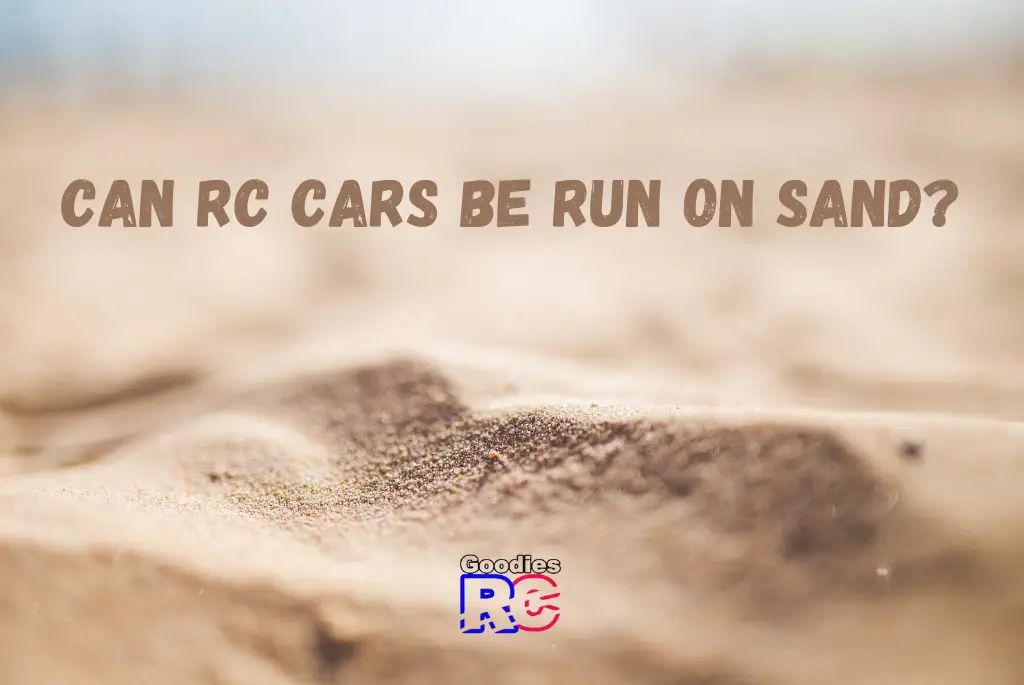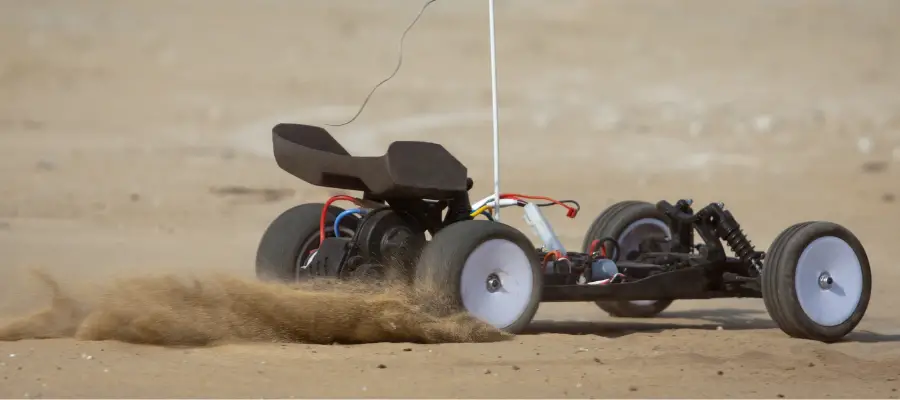Whether you own a Toy-Grade RC Car or are more invested and own a Hobby-Grade RC car, you are involved in a hobby that has fascinated people for generations. As much as other hobbies fade in and out of popularity, RC, notably RC Cars, has stood the test of time.
As a general rule, RC Cars can be run on sand. Hobby Grade RC cars tend to be better suited for the rough and tumble of sand driving. Your RC car should preferably be equipped with four-wheel drive, powerful motors, metal gears, a high ride height, and paddle wheels for sand driving.
If the RC car is suitable for running on sand, it will be a lot of fun to drive in this environment. This article discusses the types of RC cars most suitable for running on sand, the preparations to protect your RC car, and finally, the post-run actions you can take to keep your RC car running.

You Can Use Your RC Car On Sand
Driving on sand is a different experience from running on any other surface. Racing up dunes, on soft surfaces, or running from the water on a beach are all experiences you will enjoy with your RC car.
The only caveat to running your RC car on sand is that you should be prepared to carry out maintenance and cleaning at the end of the session. We will discuss this later on.
The better equipped your RC car is to run on loose soft surfaces like sand and mud, the better it will perform. The following features make your RC car suitable to run on sand.
4-Wheel Drive Is A Must
The more wheels that get traction, the better your experience. It is very frustrating to have a two-wheel drive car stuck in soft sand at the limit of your radio range. You now must trudge over the hot sand to retrieve it!
The Bigger The Car, The Better
Small cars with small wheels stand little chance against the challenge that sand presents to them. The opposite is true of big RC cars; the bigger the car, the greater its ability and the more fun you will have.
Any scale smaller than 1/10 will battle with minor rises and bumps.
The More Powerful The Motor, The Better
Sand is a challenge to most RC cars. So much of the RC car’s energy is lost as the wheels spin or push the sand down. Driving on sand uses a lot of energy, and batteries will discharge at an alarming rate.
If you have an electric motor powering your RC car, make sure the battery is fully charged and you have spares that you can install.
If the RC Car motor is any smaller than a 540, it will struggle, and you will have to regularly give it a nudge (sometimes you will be tempted to kick it!) to get it moving again.
See my related post on 540 RC motors
(Amazon link)
Metal Gears Are Best Suited To Sand
Sand is very abrasive, and it will get inside the gears of your RC car. Nylon and plastic gears will quickly get rubbed down by the abrasive sand. These materials are not up to the job and should be left for running your RC car on smooth paved surfaces.
Metal gears are better able to cope with sand getting into them, and although it won’t be good for prolonging their life, they should easily last a session of running on the sand until you can get home and give them a thorough cleaning.
(Amazon link)
The RC Car Should Have A High Ride Height
Another sand driving spec we suggest is that only RC cars that are big enough and have a high enough ride height are suitable for running on sand.
Your road-going RC Mini Cooper or Ford Mustang will not cut it on the dunes.
A Traxxas Slash 4×4 VXL Brushless is the type of RC car with the minimum capabilities to run on deep sand.
Not sure which RC Cars are best suited for sand? Check out my related article: The 8 Best RC Cars For Sand Dunes
How To Prepare Your RC Car To Run On Sand

There are some simple precautionary measures you can take and pre-run preparations you should make before running your RC car in the sand. These can be summarized as follows.
Waterproof Your RC Car
It sounds a little crazy to recommend waterproofing your RC car before running on sand. If you waterproof your car, the intention is to stop water from getting in. Well, doing this should also help keep the sand out.
If your RC car has good electrical waterproofing and the engine and gears are protected, it will be better protected against torturous dunes.
Please check out my article: How To Waterproof An RC Truck: Step By Step
Paddle Wheels Will Make Sand Driving Much Easier
While they are not essential, paddle wheels will give you a fighting chance to get up and down serious dunes.
Regular wheels, even standard off-road wheels, will slip and make it hard for the RC car to get sufficient traction. You will use a lot of energy in the process and not go very far. Paddlewheels will ensure as much energy as possible is used to move the RC car, rather than just spinning the wheels.
If you install paddle wheels, make sure you install the paddles so that they face the same way and the correct way.
(Amazon link)
Upgrade Your RC Cars Gears
If your RC car has nylon or plastic gears, it is worth the expense and effort to replace them with metal gears. The sand has a very active abrasive effect, and it will destroy plastic and nylon gears.
Check out this post: Can RC Cars Run On Water?
Special Precautions For Nitro Engines
If you have a nitro engine, you should take two additional precautions.
- Make every effort to keep sand out of the engine. It’s an excellent idea to Install an extra air filter cover. You could use an old pair of stockings (unless they are yours, get permission first!); this may slightly reduce the engine’s power, but it is worth the sacrifice.
- Smear a thin layer of grease between every part where foam meets plastic; this will help stop fine dust from getting in.
Related post: Can A Nitro RC Car Be Run In The Rain?
What Happens After Fun In The Sand With Your RC Car?
After you have run your RC car on the sand, it’s time to clean and maintain it. The following is a list of actions you should carry out.
- Check and clean the bearings. You will be surprised at where sand gets in. Take the car apart as far as possible. If you are uncomfortable, take it to your friendly RC store, and they will gladly help.
- Clean the gears. A little bit of sand can damage the gears, so thoroughly clean them.
- If you have an electric engine, use a motor spray or compressed air to give the motor a good blow-out.
- Clean the air filter. If you use a nitro engine, clean out the air filter.
- Check the play in the motor shaft. If there is a significant amount of movement, there may be damage to the bearings, and you will have to consider installing a new motor.
- Thoroughly clean all moving parts. The sand will go everywhere, so clean all hinges, hinge pins, and driveshaft couplers.
Related post: How, Where And When To Store Your RC Cars
Conclusion
If you intend to run your RC car on sand, you should Make sure your car is suited to sand driving. Spend a little time and prepare it properly to withstand the sand, and thoroughly clean and maintain it at the end of the session.
Have fun running your RC car on sand; it is worth the effort. Despite what the naysayers may say, if you look after your RC car, it will live to fight another day.

